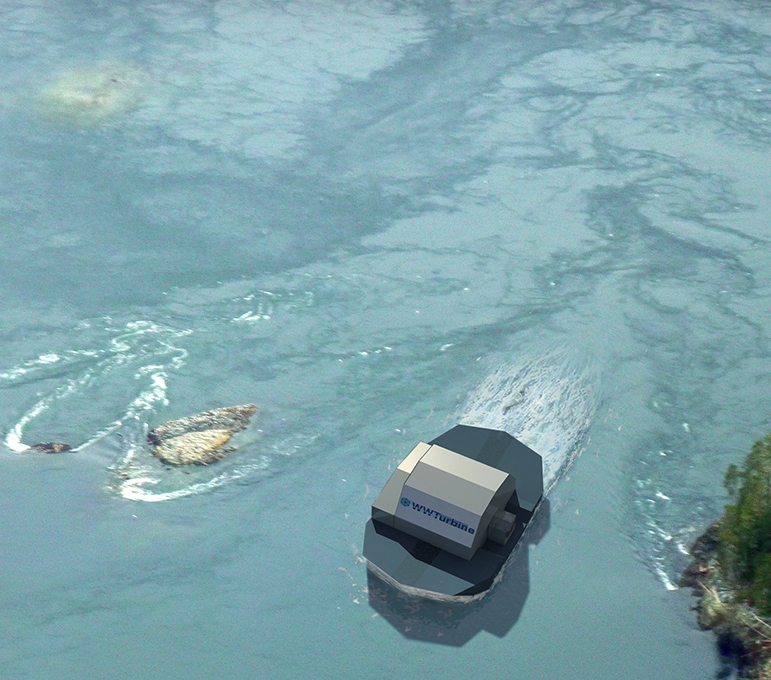Front End Engineering and Design Study (FEED) for the Dent Island Tidal Power Generation Project
Lead Proponent: Water Wall Turbine Inc.
Location: Lions Bay, BC
ecoEII Contribution: $ 300,000
Project Total: $ 600,000
Project Background:

Artist’s sketch of floating turbine structure
The extraction of potential and kinetic energy from tidal currents for conversion into electric energy is currently the subject of significant world-wide investigation. Water Wall Turbine Inc. (WWT) has developed a unique floating tidal turbine system. The “water wall turbine” is comprised of an anchored floating structure with a large paddle wheel that rotates at a slow speed of less than 20 revolutions per minute (RPM). The shaft of the wheel is connected to a gearbox that turns a generator and produces electricity.
WWT’s floating technology provides a practical solution for the shallow and narrow tidal areas of Canada’s west coast. The coast of British Columbia is dotted with off-grid remote camps and settlements – electricity at these sites is typically provided by diesel power plants and the operating costs are high. Dent Island Lodge, a remote fishing lodge off the west coast, is one such site.
Dent Island Tidal Power Generation Project proposes to power the lodge with a water wall turbine and battery storage system. EcoEII awarded $300,000 for a Front End Engineering and Design (FEED) study to define the engineering and design of a 500 kW floating tidal turbine power plant for the lodge, and the bathymetry of the project area.
Results:
Processing of bathymetric data resulted in accurate mapping of the area where the floating power plant would be anchored for testing. Currents near Dent Island during large flood/ebb tidal cycles were measured so that the energy potential of the area, and the most preferred positions for Water Wall Turbine deployment could be confirmed.
A concept design for the floating platform was proposed. The twin-hulled pontoon was designed to allow a larger volume of water flow into the turbine area. The design incorporated a ballast to raise and lower the pontoon for optimum water flow. A computational fluid dynamic (CFD) model was created for the floating system and simulations performed to determine head gain or loss due to the resistance of the turbine blades. Various anchoring combinations were considered in order to secure the floating power plant in position and optimize it for directional stability when in a current.
The data collected and analysis performed, enabled WWT to design and produce a working model of the floating power plant, at a scale of 1:6, to be field tested. During field tests, the stability of the floating structure under maximum current velocities was determined to be satisfactory. The RPM under specific current velocities and loads (torque) and various conditions were found to have good correlation with expectations. However, results of other tests indicated that there were areas that required redesigning. Design changes were made and a second series of field tests were performed. Further testing indicated that construction of a full scale system could proceed.
Benefits to Canada:
The Dent Island Tidal Power Generation Project, if realized, is expected to validate the merits of the Water Wall Turbine as a viable Canadian energy generating technology. The turbine technology is scalable to 5 MW per unit, and can be linked together to produce larger multiples of power. The flexibility of technology enables it to capture an abundance of tidal and river stream energy sources and produce emission-free renewable electric power, particularly for remote communities in Canada and around the world.
Next Steps:
The FEED study enabled WWT to complete substantial work on the design and site analysis. Credibility was gained with potential investors, as well as sub-contractors in the growing supply chain. The project is moving ahead and final design and construction is scheduled to be complete in early to mid-2015.
Find out more
Page details
- Date modified: